Preparing for and Experiencing a Prescribed Burn
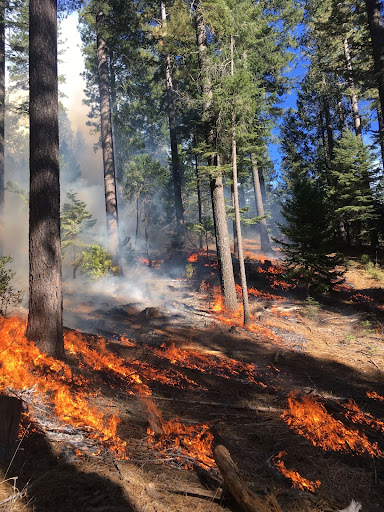

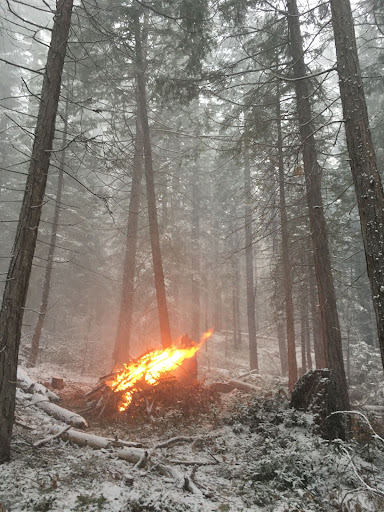
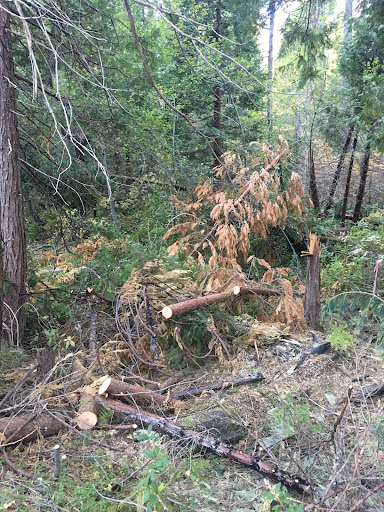
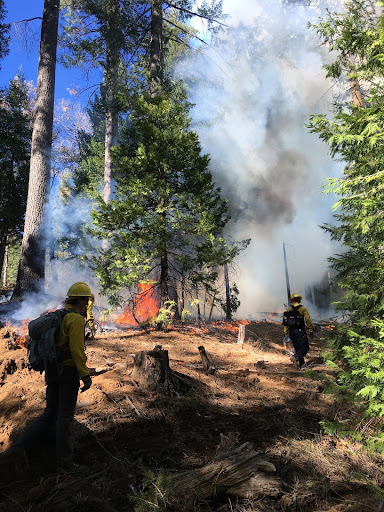
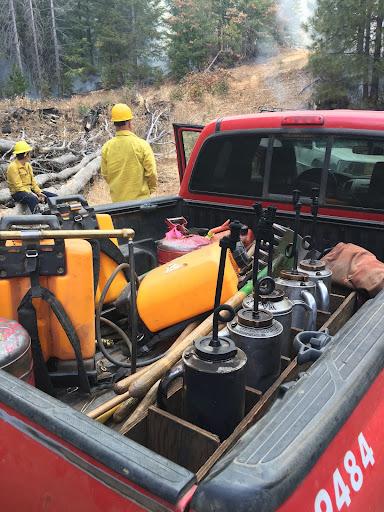
While prescribed burning has recently started to get more air time in the national conversation about reducing megafire, opportunities to experience being on a burn are still very limited.
Photos and story by: Annapurna Holtzapple, Project Associate
I have always been excited by the way that forest restoration–fire ecology–touches everything. From biodiversity protection to Indigenous land stewardship and rematriation to protecting public health and safety, putting fire back on these landscapes plays an important role. Before working as a Project Associate at Blue Forest, I spent about a year at a research station in California’s Sierra Nevada working on a whole suite of research projects, management activities, the nationwide Fire and Fire Surrogates study, and prescribed burn workshops for students and local landowners to observe, ask questions, and get more comfortable with the practices of intentional burning. By the end of my time at the research station, I loved and looked forward to prescribed burns.
Even as a student steeped in coursework about the benefits of fire ecology, the first prescribed burn I saw was unnerving. Years of seemingly continuous fire condition warnings, bans on campfires, and urban centers far from the mountains being choked by smoke made putting fire on the ground on purpose feel innately wrong and risky, despite knowing the need.
There is an immense and urgent need for forest restoration (especially thinning and burning) in these ecosystems. Like I was, many may be initially uncomfortable with fire on the landscape, despite understanding its importance for ecosystem resilience. Exposing local landowners to a prescribed burn, and allowing them to experience safely guiding the fire, is a fast way to build comfort and support for using fire as a management tool on their lands and in their communities. While prescribed burning has recently started to get more air time in the national conversation about reducing megafire, opportunities to experience being on a burn are still very limited.
Broadcast burning and pile burning
There are two types of prescribed fire that have different outcomes and objectives: broadcast burning and pile burning. Broadcast burning is when a section of forest is prepared by a land manager to burn across the forest floor. Broadcast burning is used to maintain the vegetation matrix by consuming various levels of fuel, managing brush and understory plants, and clearing out overcrowded or suppressed small trees.
The second type is pile burning, which is more similar to campfires strategically placed throughout the forest. Woody materials and debris are piled up, left to dry, and burnt. Pile burning is commonly used to remove woody material from the landscape that presents a fuel hazard, often following a management activity like a thin or harvest or storm event that creates damage and downed material in the forest.
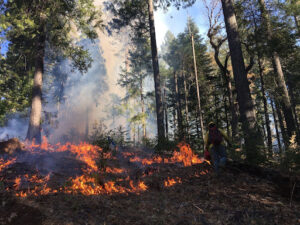
The second type is pile burning, which is more similar to campfires strategically placed throughout the forest. Woody materials and debris are piled up, left to dry, and burnt. Pile burning is commonly used to remove woody material from the landscape that presents a fuel hazard, often following a management activity like a thin or harvest or storm event that creates damage and downed material in the forest.
Indigenous cultural burning is another critical pathway for ecosystem management that has a wide suite of benefits and outcomes and is tied to different cultural and community practices. Cultural burning is unique and distinct from prescribed burning and typically has more holistic objectives, whereas prescribed burning is primarily focused on fuels reduction and decreased wildfire risk.
Preparing for a prescribed burn
The first component of broadcast burning involves intensive planning, permitting, and determining capacity requirements for both people (to light the fire and keep watch around the perimeter of the unit) and equipment (ranging from chainsaws to water holding containers on site). Planning also considers the exact location of the burn unit, size of the area, topography and current vegetation matrix, and various potential weather conditions. All of these factors are written into the prescription. The prescription itself is critical in outlining the goals of a burn, the steps needed for the burn, and specific ranges of conditions that allow a land manager to determine if a day is safe for burning. These conditions include relative humidity, fuel moisture content, temperature, and wind speed. When all these conditions align into the ranges set by the prescription, it is called a burn window and may only last for a day or two. Different agencies also require different levels and chains of approval (for example CAL FIRE and the Forest Service have their own processes and requirements for allowing fire). A properly constructed prescription tells the team that lighting a fire is safe and containable on a certain day and tells the permitting agency and signing authorities that the land manager has done the due diligence required to conduct a burn safely.
Fuels reduction is often the primary goal of a prescribed burn, but other goals can include habitat restoration, plant propagation, and safeguarding infrastructure. Establishing key goals of a burn can help determine where the burn will happen.
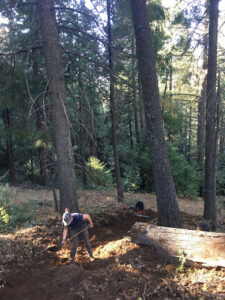
Before a burn is conducted, a land manager must prepare the site, taking tree density, unit size, and slope into account. When the area, or burn unit, is selected the fire line can be established around its perimeter. This step, called cutting a line, involves clearing away all the forest debris that may be on the ground, like leaves, branches, and pinecones (getting down to bare mineral soil along the burn unit boundary). The width of the line of bare mineral soil is generally about twice the expected flame length (these expectations are based on the prescription). Certain burns and unit sizes may call for the need and presence of water sources. This prep can include filling water storage vessels, (like water tender vehicles to transport water or mobile tanks like a pumpkin), placing and digging out flat spots for these containers to sit, and setting up hose lines to fill with water and be ready in case the fire escapes the line.
Before a burn, the team will want to identify potential dangers to the crew or risky spots where fire could escape. With the fire line prepared, the unit often is cruised for snags. Snags are dead trees that are still standing; they’re often great habitat features with lots of opportunity for cavity nesters and can be important food sources. Snags are generally not as moist as living trees, which puts them at risk of chimneying. When a tree chimneys, it burns up from the inside and can release sparks from much higher than a burn on the forest floor. The risk here is that these sparks could carry in a breeze over to other forested areas outside of the prepared area. In addition to safety, knowing where snags are and having them marked is helpful for follow up maintenance and containing the fire, as broadcast burns generally continue to burn and smolder for a few days. Snags are not as strong as living trees and have a greater risk of falling over, so crews will make sure there aren’t any snags that could potentially fall over and land outside of the fire line when they start to burn. These snags can sometimes be cut down, but due to rot and decay it is often unsafe to do so. In this case, the crew will cut a specific fire line around these snags to lower the risk of them burning and subsequently falling over.
In certain cases, prep can also include cutting a line around particularly big and old trees, other special features, or cultural resources on a landscape. As a result of decades of fire suppression, fuels of all levels have built up to hazardous levels. Ground fuels, made of leaf litter and duff material on the forest floor, have built up into thick layers on today’s forest floors. This debris layer is often slightly damp, particularly during burn windows, when some level of fuel moisture and relative humidity is required by the prescription. These combining factors mean those ground fuels can burn hot and continue to smolder for much longer than in a frequent fire regime, even lasting multiple days after the burn was conducted. While big trees in fire adapted ecosystems are adapted to low severity, low intensity fire, they are not adapted to heat on their roots and bark for extended periods of time. Prolonged heat can stress trees, damage their roots, and around the base of tree trunks, it can kill the cambium (the living cell layer of a tree trunk), thereby killing the tree. Cutting a fire line around important individual trees allows those fuels to still be consumed without risking damage to forest giants.
With fastidious planning and preparation, 99.84% of prescribed burns go according to plan. Writing a prescription takes into account many different forest conditions, weather conditions, resource constraints, objectives, and the safety of the ecosystem, nearby communities, and people working the event. Prescribed burns also require various levels of authority and permissions to get permits. While all things involve some risk, far more often than not, the biggest challenge I’ve encountered is that the prescription is so conservative that it’s actually too cold or too wet to burn, so the test fire only creeps a bit and goes out, instead of fully consuming fuel and moving across the forest floor. This can compound the challenge of finding an appropriate burn window based on the prescription. Often, a burn unit is fully prepared and the crew does all the work of set up, only to never enter a burn window, or an early snow makes the unit too wet to burn until the following year.
Performing a prescribed burn
When burning, communication amongst the team and understanding of the plan are critical. On the day of a burn, a pre-burn safety talk and emergency plan are discussed, crew members typically have radios, and there is always a clear authority and command system. The burn boss is at the top of the chain of command and responsible for lighting the test fire, starting the burn, and directing the burn crew, the people who walk through a unit with drip torches. Meanwhile, another team, the holding crew, is strategically placed on the perimeter of the burn to make sure fire doesn’t escape. The burn boss coordinates with the holding boss via radio. Everyone needs hard hats (hot air rising through the forest can knock things loose from the tree branches or even cause dead branches that were perched in the canopy to fall), eye protection, leather gloves, fire resistant clothing (like a yellow Nomex jacket), and absolutely no steel toed boots (it gets mighty hot to walk through a fire as is, without hot metal in your shoes).
Before a burn fully begins, the burn boss lights a test fire in a smaller prepared area of the unit to confirm that the fire is behaving and responding the way the team and burn boss expect. Sometimes a test fire indicates the fire may burn hotter than expected or that the conditions are actually too damp for fire to carry and consume material and the crew may have to wait until another time.
After the test fire is completed, burning throughout the unit is done in a staggered line. The burn boss leads, while other team members wait for them to get into the unit, and then start lighting another line of fire a few feet down from them. By staggering the ignitions, you avoid trapping the person in front of you with fire on both uphill and downhill sides. Some images of this are below. Spacing depends on the fire and how hot it is burning, but generally you don’t want to trap your team, and you want fire to burn for a few feet before running into the already burned area. The burn crew lights from behind them, generally walking a pace or so ahead of where the drip torch is putting light down. Burn units can also be big enough that they have to be lit over several consecutive days, which is sequenced by the burn boss based on weather conditions, human capacity and resources available, and the prescription.
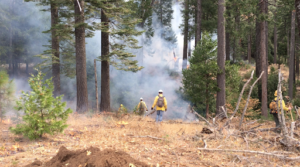
Typically, broadcast burns start uphill or at the top of a unit, and you work your way downhill. Generally speaking, fire can run fast uphill, with rising heat drying out or “preheating” the fuel above it. Starting from the top of a hill and working down creates a back burn or area of consumed fuel leading up to the fire line. If a fire should start to get too hot and burn uphill, the back burned area doesn’t have much debris, which makes it easy to prevent the fire from jumping the line and spreading into the other areas of the forest.
Drip torches are the tool that is actually used for lighting and spreading fire across the unit. They have a long wick that gets soaked in fuel and lit. Fuel is held in the canister and is typically a mix of gas and diesel with ratios varying depending on how hot the burn should be There is a long straw for fuel to leave the canister, with a little loop to prevent fire from climbing back up the stem and entering the torch. As fuel falls out of the drip torch, it lands on the wick and is lit, then landing on and lighting the forest floor. Other tools typically present are water backpacks (exactly what it sounds like: a backpack full of water with a little garden-hose-like sprayer), hoes, chainsaws, McLeods, and shovels. These are good to have on hand in case you need to control an escape or protect an area.
Depending on conditions, the size, and the prescription, sometimes burn units are cruised through the night and following days, walking the perimeter regularly to ensure fire has not escaped or fallen out of the unit and that the fire line is still clear of forest debris that could carry fire across the line. Sometimes dead tree stumps can smolder underground for a long time or burn into underground dead root systems. Before a fire is considered over and left unattended, the crew will mop up hazards like this by ensuring that fire is all the way extinguished in the unit and putting out smoldering logs or underground roots with water and shovels. It is most ideal to burn a few days before a forecasted rain or snow event, so you know that incoming precipitation will put out any remaining flames and make the forest too wet to continue to burn. Due to the urgent need for fire on the ground and the limited opportunities to burn, land managers tend to burn once a prescription is entered even if it will require longer monitoring time. Fall burns happen before rain and cool temperatures, and require less monitoring than spring burns that happen before the summer and rising temperatures.
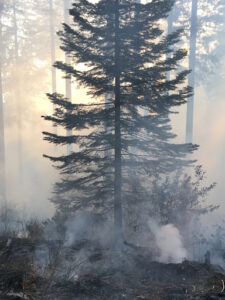
Having the upfront capital necessary for a project and the flexible funds to support needs that may arise such as a burn window opening suddenly, can help accelerate project implementation and increase the acreage of work on a landscape. Blue Forest leverages conservation finance to increase the opportunity for prescribed fire as a land management tool. It is important for land managers to be able to have the confidence and comfort with fire to allow them to move swiftly and bring resources to a unit to seize opportunities to light when a prescription is entered. By getting more landowners and community members comfortable with the idea of fire and the practices of preparation that go into making it safe, both pile burning and broadcast burning can become widespread and tools for forest management.